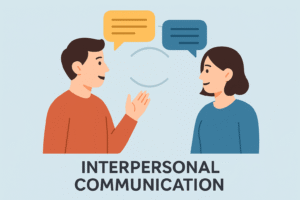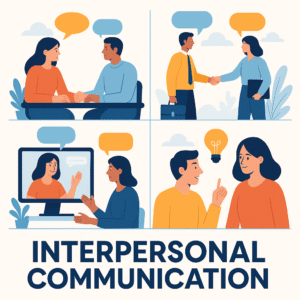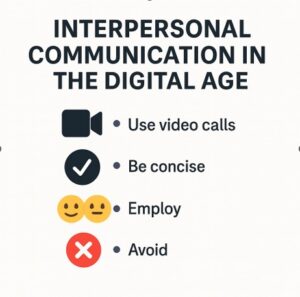“It’s not just what you say — it’s what they hear, understand, and feel.”
Introduction: Beyond Words
In today’s hyper-connected professional and personal environments, interpersonal communication is not merely an exchange of information — it is the lifeblood of collaboration, trust, and innovation. Whether you’re leading a team, negotiating a deal, or resolving a conflict, how you communicate influences the outcome far more than just what you say.
This blog explores the essence, elements, challenges, and enhancement strategies of interpersonal communication, with a real-life application to drive home its value.
What is Interpersonal Communication?
Interpersonal communication is the process of exchanging ideas, feelings, and information through verbal and non-verbal channels. It typically occurs between two or more individuals and may be intentional or unintentional. In every interpersonal communication process, a sender initiates the message, and a receiver interprets and responds to it. The message itself may be verbal or non-verbal, and the transmission medium can be spoken words, written text, gestures, or facial expressions. Feedback from the receiver helps complete the communication loop, ensuring understanding or indicating the need for clarification. Interpersonal communication thrives when the exchange is dynamic, respectful, and responsive to emotional cues and social context.

Verbal and Non-Verbal Communication: A Synergistic Duo
Verbal communication involves the use of spoken or written words. Its effectiveness depends heavily on tone of voice, pitch, choice of words, clarity, and timing. Even the most meaningful message can be misunderstood if not articulated clearly or delivered in an appropriate tone.
On the other hand, non-verbal communication includes facial expressions, body language, gestures, posture, eye contact, and even silence. Research indicates that non-verbal signals often carry more weight than verbal ones. A mismatch between what is said and how it is expressed — for example, saying “I’m fine” while visibly distressed — can lead to confusion or erode trust.

Barriers to Effective Interpersonal Communication
Several factors can obstruct clear and meaningful communication.
- Noise, both physical (like background chatter) and psychological (such as stress or bias), can distort the intended message.
- Cultural and linguistic differences may lead to misunderstandings, especially in global teams.
- Assumptions and stereotypes often cloud judgment and cause premature conclusions.
- Lack of active listening — where one focuses on responding rather than understanding — undermines the communicative process.
- Emotional interference, such as anger or anxiety, can also make people more reactive than reflective.
- Finally, over-reliance on technology may reduce face-to-face interaction and diminish the richness of communication through non-verbal cues.

Enhancing Your Interpersonal Communication Skills
- Practice Active Listening:
- Don’t just wait to speak — listen to understand.
- Paraphrase, nod, and give feedback to demonstrate attention.
- Be Mindful of Your Body Language:
- Maintain open posture, appropriate eye contact, and natural gestures.
- Avoid defensive cues like crossing arms or looking away.
- Speak Clearly and Concisely:
- Use simple, direct language.
- Match your tone to the context and audience.
- Develop Emotional Intelligence (EQ):
- Recognize your emotions and those of others.
- Use empathy to guide interactions and resolve conflicts.
- Adapt to Context and Personality Types:
- Tailor your style when speaking to different individuals (e.g., introverts vs. extroverts, analytical vs. emotional personalities).
- Be culturally sensitive.
- Solicit and Respond to Feedback:
- Ask for clarity when unsure and offer feedback respectfully
- Use feedback as a tool for continuous improvement.
Interpersonal Communication in the Digital Age
Interpersonal communication has taken new forms with the rise of virtual meetings, emails, and chat-based interactions. However, digital communication often lacks tone and non-verbal cues, making intentionality, clarity, and empathy even more critical.
- Use video calls, when possible, for a richer communication experience.
- Be concise and precise in written communication.
- Employ emojis and punctuation (judiciously) to convey tone.
- Avoid misunderstandings by overcommunicating essential details.

Conclusion: Communication is a Leadership Superpower
Mastering interpersonal communication is a soft skill and a core leadership capability. It fosters trust, nurtures collaboration, prevents conflict, and accelerates innovation. Whether you’re a student, professional, or entrepreneur, investing in your communication skills is investing in your personal growth and organizational success. So the next time you speak, write, or listen, pause, reflect, and remember: every interaction is a chance to connect, influence, and inspire.





Leave a Reply